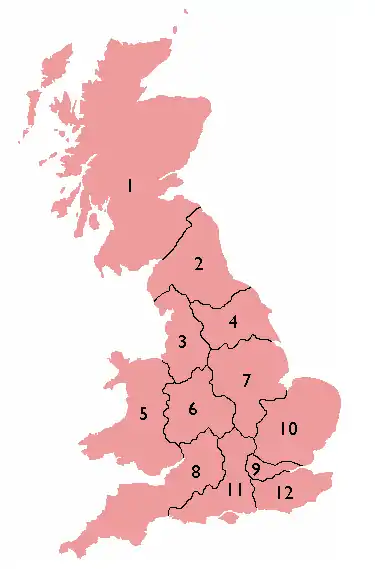Gas board
The area gas boards were created under the provisions of the Gas Act 1948 enacted by Clement Attlee's post-war Labour government. The Act nationalised the British gas industry and also created the Gas Council.
| Type | Nationalised companies (controlled by HM Government and reporting to the Ministry of Power) |
|---|---|
| Industry | Utilities (energy: gas) |
| Predecessor | 1812 (as the Gas Light and Coke Company and various others) |
| Founded | 1 May 1949 (by the Gas Act 1948) |
| Defunct | 31 December 1972 |
| Fate | Reorganisation under the Gas Act 1972 |
| Successor | British Gas Corporation (by the Gas Act 1972) |
Area served | Great Britain |
Key people | Board members[1] |
| Products | Coal gas, natural gas |
| Services | Gas and coke supply |
History
From the early 19th century the gas supply industry in the United Kingdom was mainly operated by local authorities and private companies.[2] A flammable gas (known as "town gas" or "coal gas") was piped to commercial, domestic and industrial customers for use as a fuel and for lighting. It was marketed to consumers by such means as the National Gas Congress and Exhibition in 1913. The gas used in the 19th and early 20th centuries was coal gas but in the period 1967–77 coal gas supplies were replaced by natural gas, first discovered in the UK North Sea in 1965.
Nationalisation
In 1948 Clement Attlee's Labour government reshaped the gas industry, enacting the Gas Act 1948. The act nationalised the UK gas industry and 1,064 privately owned and municipal gas companies were merged into twelve area gas boards each a separate body with its own management structure.[3] Under the Gas Act 1948 the area boards were charged with three duties:[4]
- To develop and maintain an efficient, co-ordinated and economical system of gas supply for their areas and to satisfy, so far as it is economic to do so, all reasonable demands for gas within their area.
- To develop and maintain the efficient, co-ordinated and economical production of coke, other than metallurgical coke.
- To develop and maintain efficient methods of recovering by-products obtained in the process of manufacturing gas.
Management board
The management board for each area board typically comprised:[4]
- Chairman
- Deputy chairman
- Chief engineer
- Controller of research
- Controller of services
- Commercial manager
- Public relations officer
- Secretary
- Chief accountant
- Staff controller
The chairman of each area board was a member of the Gas Council. Each area board was divided into geographical groups or divisions which were often further divided into smaller districts. These boards simply became known as the "gas board", a term people still use when referring to British Gas, the company that replaced the boards when the Gas Act 1972 was passed. The area boards became regions of the British Gas Corporation.[2]
Area gas boards

Arms
|
References
- "Area gas board members". Parliamentary Debates (Hansard). 10 February 1949. Retrieved July 17, 2012.
- Williams, Trevor I. (1981). A History of the British Gas Industry. Oxford: Oxford University Press. ISBN 0198581572.
- "Nationalisation". Archived from the original on January 21, 2012. Retrieved July 17, 2012.
- Falkus, Malcolm (1988). Always under Pressure - A History of North Thames Gas since 1949. London: Macmillan. pp. 18, 23. ISBN 0333468198.
- "Southern Gas Board". Heraldry of the United Kingdom. Retrieved 2 February 2021.